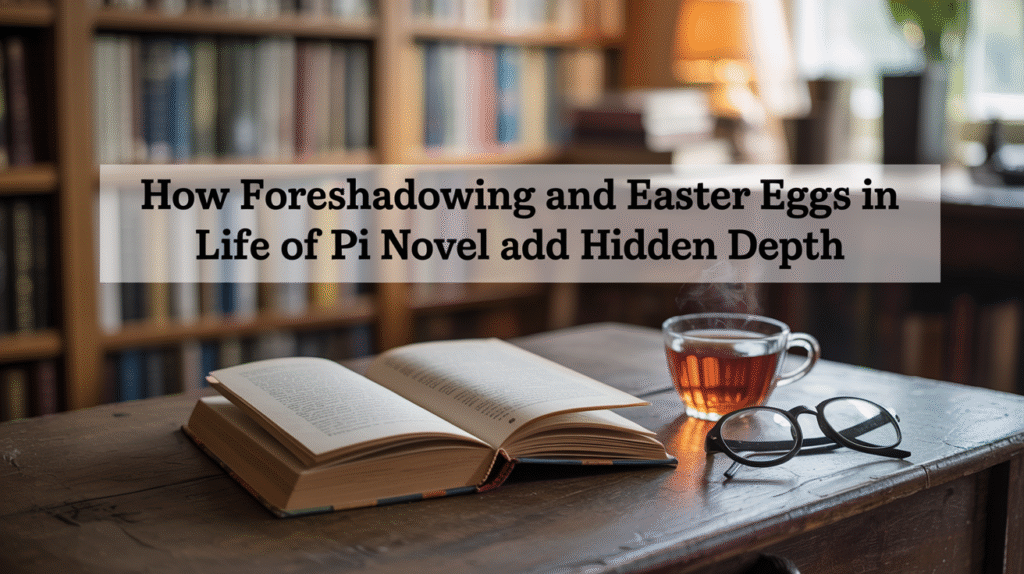Foreshadowing and subtle clues in Life of Pi prepare readers for its major twists, including the shocking alternative version of Pi’s survival story. These narrative elements enhance reread value and deepen the novel’s thematic complexity.

Here’s how foreshadowing and hidden details shape the story’s impact and offer clues readers might have missed the first time around.
Early Clues Hint at Dual Realities
From the very beginning, Martel leaves breadcrumbs that the story might not be as straightforward as it seems.
“A Story That Will Make You Believe in God”
- This line primes the reader to expect a spiritual rather than a literal journey.
- It sets up the theme of interpretative truth versus factual truth.
Foreshadowing the Ending
- The author’s notes and tone suggest ambiguity.
- Pi’s calm demeanor in adulthood hints that the most horrific parts of the story may be hidden or altered.
Animal-Human Symbolism Is Introduced Early
The idea that the animals could symbolize humans is suggested before the twist ending.
Zoo Knowledge as a Set-Up
- Pi’s early explanations of animal behavior mirror the actions of the “characters” on the lifeboat.
- His father’s lesson about the tiger’s nature warns the reader to view animals with a double lens.
Introductions with Dual Meanings
- The zebra, orangutan, hyena, and tiger all exhibit behaviors that later match those of their human counterparts in the second story.
- This duality is not overt—but it’s there for readers paying close attention.
Dreams, Hallucinations, and Metaphors Offer Veiled Hints
The novel includes surreal events that serve both as narrative moments and symbolic warnings.
The Blind Frenchman
- A hallucinated companion who may represent cannibalism and moral disintegration.
- Hints at the real acts Pi might have committed while alone or with others at sea.
The Floating Island
- A false paradise that turns out to be carnivorous—just like comforting lies that mask traumatic truths.
- Symbolizes the emotional danger of not facing reality.
Recurring Themes Suggest There’s More Beneath the Surface
Certain ideas and motifs are repeated often, inviting readers to question the story’s surface-level interpretation.
Faith vs Fact
- Repeated discussions about religion and science prepare readers for the moral decision of choosing a better story over a true one.
- The dual narrative is an allegory for the broader debate between rationalism and spirituality.
Survival and Savagery
- Pi’s gradual transformation into a hunter foreshadows the possibility that he was capable of violence and even murder.
- His justification for coexisting with Richard Parker hints at inner compartmentalization.
Dialogue That Signals Deeper Layers
Even casual dialogue in the book includes lines that take on new meaning after the twist.
“You must choose your story.”
- Said by Pi, this line isn’t just philosophical—it’s a clue.
- The book challenges the reader to choose between the beautiful fiction and the brutal truth.
“Which is the better story?”
- Delivered near the end, this line re-frames the entire novel and forces reflection.
- It’s Martel’s final hint that storytelling is about belief, not fact.
Visual and Structural Hints in the Writing
Yann Martel uses the structure and pacing of the book itself to foreshadow its philosophical pivot.
Shift in Tone
- The first part of the book is lyrical and reflective; the survival section is intense and primal.
- The abrupt return to calm in the interview scenes sets up a contrast that makes the twist more impactful.
Ending Comes Full Circle
- The return to real-world narration mirrors the beginning of the book.
- It emphasizes that the entire story is a construct, possibly designed to convey meaning over accuracy.
FAQ: Foreshadowing and Clues in Life of Pi
Here are some questions and answers about the hidden details and foreshadowing in Life of Pi.
What is foreshadowed in Life of Pi?
The possibility that Pi’s story with animals is fictional is foreshadowed through tone, dialogue, and early symbolic parallels between animals and humans.
Are there clues that the animals are metaphors?
Yes. The animals’ behaviors match specific human traits, and Pi’s deep knowledge of animal psychology suggests the metaphorical use of each creature aboard the lifeboat.
What does the floating island symbolize?
The island represents a deceptive refuge that masks danger—similar to comforting lies that shield one from traumatic truths. It’s also a warning against spiritual complacency.
What’s the biggest Easter egg in the novel?
The dual narrative itself is the largest hidden layer—only revealed at the end. Smaller clues include the parallel traits between animals and humans and the sudden tonal shifts.
Why does Martel include foreshadowing and hidden clues?
They encourage readers to engage deeply with the story and its themes. These clues support the novel’s central question about belief, storytelling, and emotional truth.
The beauty of Life of Pi lies in its layers. By paying attention to its subtle foreshadowing and symbolic clues, readers uncover a story far more complex—and rewarding—than it first appears.
